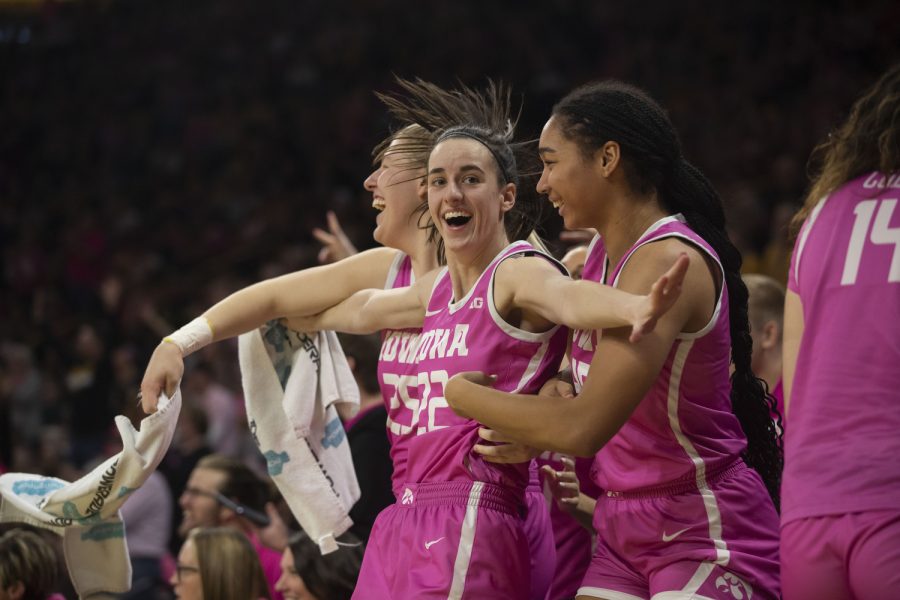Opinion | The complexities of the women’s basketball national player of the year race
The women’s basketball national player of the year honor has multiple factors, but it should come down to the best player in the country — and Caitlin Clark is that player.
Iowa guard Caitlin Clark (22) celebrates during a basketball game between No.5 Iowa and Rutgers at Carver Hawkeye Arena in Iowa City on Sunday, Feb. 12, 2023. The Hawkeyes defeated the Scarlet Knights, 111-57.
February 14, 2023
Head coach Lisa Bluder’s mind was made up after junior guard Caitlin Clark’s performance in Iowa’s 96-82 victory against Maryland on Feb. 2.
Clark, a national player of the year candidate, dropped 42 points, eight assists, and seven rebounds against what was the No. 8 team in the country that night.
“I don’t know how you cannot say that Caitlin Clark is not the national player of the year,” Bluder said postgame. “I don’t know how you can say that she is not. She was unbelievable.”
Obviously, Bluder is biased toward her own player, but Clark has an almost impenetrable case to become the national player of the year.
The key word here: almost.
Last March, I wrote a column that will end up sounding very similar to this one: Caitlin Clark should be the national player of the year.
She didn’t end up winning the national award in the 2021-22 season. She was nominated for all four major national honors — the Wooden, Naismith, and USBWA Awards and the Wade Trophy — but fell short in all of them.
I’ll say this again: My opinion isn’t a homer take as a University of Iowa student. Clark was arguably the most impactful player on the court in 2021-22, leading the nation with 27 points and eight assists per game. She also added on an average of eight rebounds per game as a point guard.
But the politics of the women’s national player of the year comes down to team rankings.
Clark said she doesn’t take any stock in becoming the national player of the year because she knows her team needs to succeed first.
“As long as my team wins, all that takes care of itself,” Clark said. “It’s not something that I think about every day, but that is a huge honor. And it’s you know, even last year when I was in the conversation for it, it is a huge honor. It’s a huge honor for our team, for our program to have players in that conversation.”
Aliyah Boston was the unanimous national player of the year in 2021-22 after leading South Carolina women’s basketball to a 36-2 season (and an NCAA Championship, but voters chose before the postseason).
Boston impressively had 30 straight double-doubles throughout the 2021-22 season, averaging 16.8 points and 12.8 rebounds during the season. But she didn’t impact her team as much as Clark did.
Boston is a player that transcends the game — she’s continuing to do so this season, and she’ll likely be the No. 1 pick in the 2023 WNBA Draft.
The difference between Boston and Clark, both last season and this season, is that Boston plays for the No. 1 team in the nation. Voting for the national player of the year seems simple — the best player on the best team has to be it, right?
I think it’s more complex than that.
The national player of the year shouldn’t be the best player on the best team. To be the No. 1 team in the nation, there needs to be multiple highly skilled players working in tandem.
The national player of the year should be the person who’s had the most impact on her team.
This season (and arguably last season), Clark is the player who’s had the most impact on their team. In 2022-23, she is second in the nation with 27.4 points per game and first with 8.3 assists. Along with 7.6 rebounds per game, the junior is nearly averaging a triple-double throughout a grueling Big Ten season.
“I think it’s the best player in the United States,” Bluder said on her national player of the year criteria. “That’s what I think she is. I think she is the national player of the year. When you look at what she does and compare that to what other people can do, nobody can do what she can do, nobody in the country.”
Now, there’s arguments to be made this season for Boston, who is averaging 13.4 points and 9.9 rebounds per game; LSU’s Angel Reese, who is averaging a staggering 15.3 rebounds per game; and Indiana’s Mackenzie Holmes, who averages 22.5 points and 7.5 rebounds per game.
But there’s a difference between those three frontcourt players and Clark: Their job is to bring down rebounds. Clark excels in rebounding when her job as a point guard is to bring the ball up the court. Technically, she’s not allowed to crash the boards for offensive rebounds.
Bluder described comparing Clark, a guard, to a post player or forward as “apples to oranges.”
“They are two totally different positions,” Bluder said. “And that’s why it’s kind of nice we have the Nancy Lieberman Award and the Ann Meyers Drysdale award and the Lisa Leslie Award.”
Apples to oranges aside, Clark is by far the most impactful player in women’s college basketball. And she deserves an award that will show that impact.
Columns reflect the opinions of the authors and are not necessarily those of the Editorial Board, The Daily Iowan, or other organizations in which the author may be involved.




